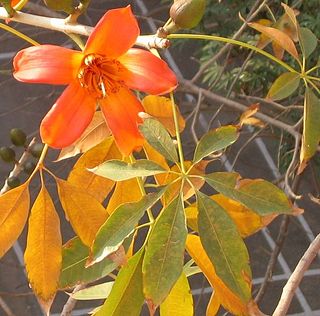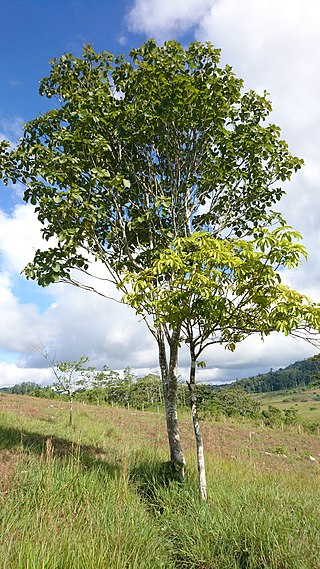
Alpinia is a genus of flowering plants in the ginger family, Zingiberaceae. Species are native to Asia, Australia, and the Pacific Islands, where they occur in tropical and subtropical climates. Several species are cultivated as ornamental plants.

Bombax is a genus of mainly tropical trees in the mallow family. They are native to western Africa, the Indian subcontinent, Southeast Asia, and the subtropical regions of East Asia and northern Australia. It is distinguished from the genus Ceiba, which has whiter flowers.

Theobroma is a genus of flowering plants in the mallow family, Malvaceae, that is sometimes classified as a member of Sterculiaceae. It contains roughly 20 species of small understory trees native to the tropical forests of Central and South America.

Bertiera is a genus of flowering plants in the family Rubiaceae. It comprises 57 species with most known from tropical Africa, five known from various Indian Ocean islands and five found in the tropics of the Americas.

Simira is a genus of plants in the family Rubiaceae. The genus was first published by French pharmacist and botanist Jean Baptiste Christophore Fusée Aublet in Hist. Pl. Guiane vol.1 on page 170 in 1775.

Duroia is a genus of flowering plants in the family Rubiaceae. The genus is found from Costa Rica to tropical South America.

Chomelia is a genus of flowering plants in the family Rubiaceae. It is native to Mexico, Central America, the West Indies, and much of South America as far south as Argentina.

Calycophyllum is a genus of flowering plants in the family Rubiaceae. It was described by Augustin Pyramus de Candolle in 1830. The genus is found from Mexico, Central America, South America and the West Indies.

Rauvolfioideae is a subfamily of the flowering plant family Apocynaceae. Many species are woody lianas, others are shrubs or perennial herbs.
Declieuxia is a genus of flowering plants in the family Rubiaceae. The genus is found in tropical America.

Spermacoceae is a tribe of flowering plants in the family Rubiaceae and contains about 1346 species in 57 genera. Its representatives are found in the tropics and subtropics.

Pseudobombax longiflorum is a species of flowering plants of the family Malvaceae. It is found in Bolivia and Brazil.
Staelia is a genus of flowering plants belonging to the family Rubiaceae.
Sipaneopsis is a genus of flowering plants belonging to the family Rubiaceae.

Psyllocarpus is a genus of flowering plants belonging to the family Rubiaceae. It is an endemic genus of Brazil found in Amazonia, Caatinga, and Cerrado. In 1979 the genus was revised by Kirkbride into two sections, Psyllocarpus sect. Psyllocarpus and P. sect Amazonica, based on geographic distribution and morphology. Plants of the World Online treats the genus as a synonym of Tapanhuacanga.

Eumachia is a genus of flowering plant in the family Rubiaceae. Its species are native to tropical and subtropical regions worldwide. The genus was established by Augustin Pyramus de Candolle in 1830.












